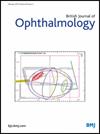3D facial reconstruction refines 60-4 visual field assessment
IF 3.5
2区 医学
Q1 OPHTHALMOLOGY
引用次数: 0
Abstract
Background This study aimed to provide methodology to create a facial contour-informed normative 60-4 visual field and to apply the reference field to a glaucoma cohort to derive facial contour-informed 60-4 global indices. Methods Participant recruitment was completed at a tertiary medical centre. 60 eyes from 30 participants with no ocular pathology by clinical exam or optical coherence tomography were recruited for the healthy cohort. For the glaucoma cohort, 86 eyes from 43 patients diagnosed with glaucoma by clinical exam were recruited, with 30-2 visual field mean deviation used to stratify glaucoma severity. Results The median (range) age of the healthy participants was 33 (24–61) years old. A facial contour-informed 60-4 visual field reference field was developed. 43 glaucoma patients were recruited with a resulting median (range) age of 65 (30–84). Three algorithms compensating for facial contour were used for the derivation of 60-4 mean deviation and pattern SD. All mean deviation algorithms correlated with 30-2 mean deviation severity (ρ≤−0.62, p<0.0001) and retinal nerve fibre layer thickness (ρ≥0.36, p<0.05). For pattern SD, consideration of inferior nasal defects allowed correlation with both 30-2 mean deviation severity (ρ≥0.49, p<0.001) and retinal nerve fibre layer thickness (ρ≤−0.47, p<0.01). Conclusion This study provides methodology for deriving a facial contour-informed 60-4 reference field and illustrates the feasibility of applying facial contour information to refine global indices of the 60-4 visual field. Obtained metrics compensated for facial contour and correlated with functional and structural disease metrics. All data relevant to the study are included in the article or uploaded as supplementary information.3D面部重建细化了60-4的视野评估
本研究旨在提供一种方法来创建一个面部轮廓知情的标准60-4视野,并将参考视野应用于青光眼队列,以获得面部轮廓知情的60-4全局指数。方法在三级医疗中心完成参与者招募。来自30名临床检查或光学相干断层扫描无眼部病理的参与者的60只眼睛被招募为健康队列。对于青光眼队列,从43例经临床检查诊断为青光眼的患者中招募86只眼睛,使用30-2的视野平均偏差对青光眼的严重程度进行分层。结果健康受试者年龄中位数(范围)为33岁(24 ~ 61岁)。建立了基于面部轮廓的60-4视野参考视野。招募了43名青光眼患者,结果中位年龄(范围)为65岁(30-84岁)。采用3种面部轮廓补偿算法对60-4均值偏差和模式SD进行求导。所有平均偏差算法均与30-2平均偏差严重程度(ρ≤- 0.62,p<0.0001)和视网膜神经纤维层厚度(ρ≥0.36,p<0.05)相关。对于模式SD,考虑下鼻缺损与30-2平均偏差严重程度(ρ≥0.49,p<0.001)和视网膜神经纤维层厚度(ρ≤- 0.47,p<0.01)相关。结论本研究提供了一种基于面部轮廓的60-4参考视场的生成方法,并说明了应用面部轮廓信息来细化60-4视野全局指标的可行性。所获得的指标补偿了面部轮廓,并与功能和结构疾病指标相关。所有与研究相关的数据都包含在文章中或作为补充信息上传。
本文章由计算机程序翻译,如有差异,请以英文原文为准。
求助全文
约1分钟内获得全文
求助全文
来源期刊
CiteScore
10.30
自引率
2.40%
发文量
213
审稿时长
3-6 weeks
期刊介绍:
The British Journal of Ophthalmology (BJO) is an international peer-reviewed journal for ophthalmologists and visual science specialists. BJO publishes clinical investigations, clinical observations, and clinically relevant laboratory investigations related to ophthalmology. It also provides major reviews and also publishes manuscripts covering regional issues in a global context.

 求助内容:
求助内容: 应助结果提醒方式:
应助结果提醒方式:


